Before I tell you what it was like to join the 5 million cars on the streets of Bangkok and tell you what it means to be in a Kingdom, let me finish part of what I told you yesterday about agriculture in Thailand. I looked at the CIA factbook this morning, and learned four numbers that will help put it in perspective. First, agriculture contributes about 11% to the GNP of Thailand, but employs 40% of the population, which is to say that 60% of the population contributes 90%. Third, if labor costs were as at the cannery/plantation (around $2,500) but the average income is over $8,700, then a lot of people have a much lower than average income. However (and this is a typical economist trick—on the other hand), unemployment is under 1.5%.
This morning, and most of the day today, we were 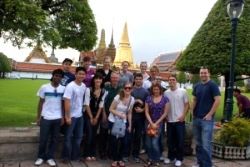 one bus on the road to three royal residences. The first, the Grand Palace, was built by the first King of modern Siam (the country became Thailand in 1939) when he moved the capital across the river from Thonburi to Bangkok in 1782. The Grand Palace is probably the “face” of Thailand, with its temple complex housing the Emerald Buddha. It symbolically states that the King of Thailand fits squarely into the Hindu-Buddhist tradition of the Ramayana, the great Hindu books
one bus on the road to three royal residences. The first, the Grand Palace, was built by the first King of modern Siam (the country became Thailand in 1939) when he moved the capital across the river from Thonburi to Bangkok in 1782. The Grand Palace is probably the “face” of Thailand, with its temple complex housing the Emerald Buddha. It symbolically states that the King of Thailand fits squarely into the Hindu-Buddhist tradition of the Ramayana, the great Hindu books  about the battle between good and evil. The current king is Rama IX, with all the kings having been named “Rama.” The temple part houses the statues of Rama and other figures from the Ramayana, such as the monkey king, Hanuman, who leads the forces of good. The chedi and stupas (the tops of the temples) and much of the temples, in fact, are covered with glistening gold leaf and colored cut glass that make this one of the more colorful palaces in the world.
about the battle between good and evil. The current king is Rama IX, with all the kings having been named “Rama.” The temple part houses the statues of Rama and other figures from the Ramayana, such as the monkey king, Hanuman, who leads the forces of good. The chedi and stupas (the tops of the temples) and much of the temples, in fact, are covered with glistening gold leaf and colored cut glass that make this one of the more colorful palaces in the world.
Exiting from the temple part of the complex, we left the world of the Ramayana (the book has seven volumes, I believe; when I read the abridged version, I was reminded of the bewildering complexity of German folk tales, on which several Wagnerian operas are based!) for the later efforts of Siamese kings to prevent absorption into the European empires by adopting many features of Europe (see The King and I for a thinly fictionalized version of the story of Mongkut’s bringing in a school teacher for his many children). In the newer part of the palace (the only part regularly used today—as a guest house for royal guests), the buildings are a Thai-European 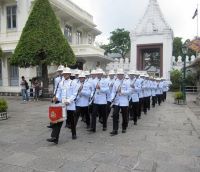 confection, with European palace buildings topped by the traditional Thai roofs. The whole palace is guarded, but the changing of the guard is performed by troops with modern rifles, with dress uniforms including a white pith helmet. It won’t confuse you with London, but the similarities with European practice are there.
confection, with European palace buildings topped by the traditional Thai roofs. The whole palace is guarded, but the changing of the guard is performed by troops with modern rifles, with dress uniforms including a white pith helmet. It won’t confuse you with London, but the similarities with European practice are there.
My favorite external part is the elephant stand, where the king can mount-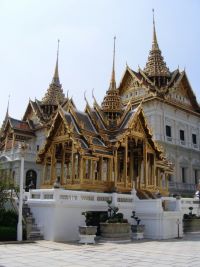 dismount his elephant–the traditional transportation—not to mention the heavy infantry of the warfare in this part of the world, an area that until the Europeans conquered it was marked by Burmese-Siamese wars. Bangkok became the capital because the Burmese generals devastated the former capital, Ayudhya (again named for a place in the Ramayana). Siam escaped colonization (the Thais will point out that the country was the only one in SE Asia not to fall under European control) partly because it served as a buffer between the French in Indochina and the British in the Malay States and the Straits Settlements, as well as India.
dismount his elephant–the traditional transportation—not to mention the heavy infantry of the warfare in this part of the world, an area that until the Europeans conquered it was marked by Burmese-Siamese wars. Bangkok became the capital because the Burmese generals devastated the former capital, Ayudhya (again named for a place in the Ramayana). Siam escaped colonization (the Thais will point out that the country was the only one in SE Asia not to fall under European control) partly because it served as a buffer between the French in Indochina and the British in the Malay States and the Straits Settlements, as well as India.
Of the other palaces we visited (the king today lives in yet another one, and I know we will be near still another one when we journey by train tomorrow) one was built by a late 19th century king, and, even before air conditioning, had large windows, high roofed rooms, and other features to capture whatever breeze there might have been. Given the power of the king (he was absolute ruler until a coup in 1932 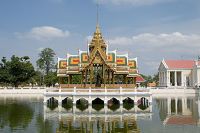 established a constitutional monarchy), there were undoubtedly a number of servants whose job it was to fan the royal family. Even today, a large staff maintains the grounds impeccably. I told Professor Sikora, my colleague and co-leader, we needed to bring the gardeners home to give us the kind of yard the king enjoyed.
established a constitutional monarchy), there were undoubtedly a number of servants whose job it was to fan the royal family. Even today, a large staff maintains the grounds impeccably. I told Professor Sikora, my colleague and co-leader, we needed to bring the gardeners home to give us the kind of yard the king enjoyed.
This evening we got to enjoy a view of the Bangkok from the river, past the royal palace with its royal barge landing, to the residence of royal commoners today, the Mandarin Oriental (formerly the Oriental hotel), which is always listed in the top ten hotels in the world. When I was here 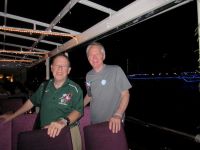 with Mrs. Hoyt in 2001, we stayed at the Oriental, where I bet we are listed among the famous people who have made it their temporary home. I might lose that bet, but I think you understand why I’m tired. Its 11:30 tonight, and we have a lot to do tomorrow. We leave Bangkok for Malaysia tomorrow, so if I don’t get online until then, may I wish all the moms out there a happy Mother’s May?
with Mrs. Hoyt in 2001, we stayed at the Oriental, where I bet we are listed among the famous people who have made it their temporary home. I might lose that bet, but I think you understand why I’m tired. Its 11:30 tonight, and we have a lot to do tomorrow. We leave Bangkok for Malaysia tomorrow, so if I don’t get online until then, may I wish all the moms out there a happy Mother’s May?